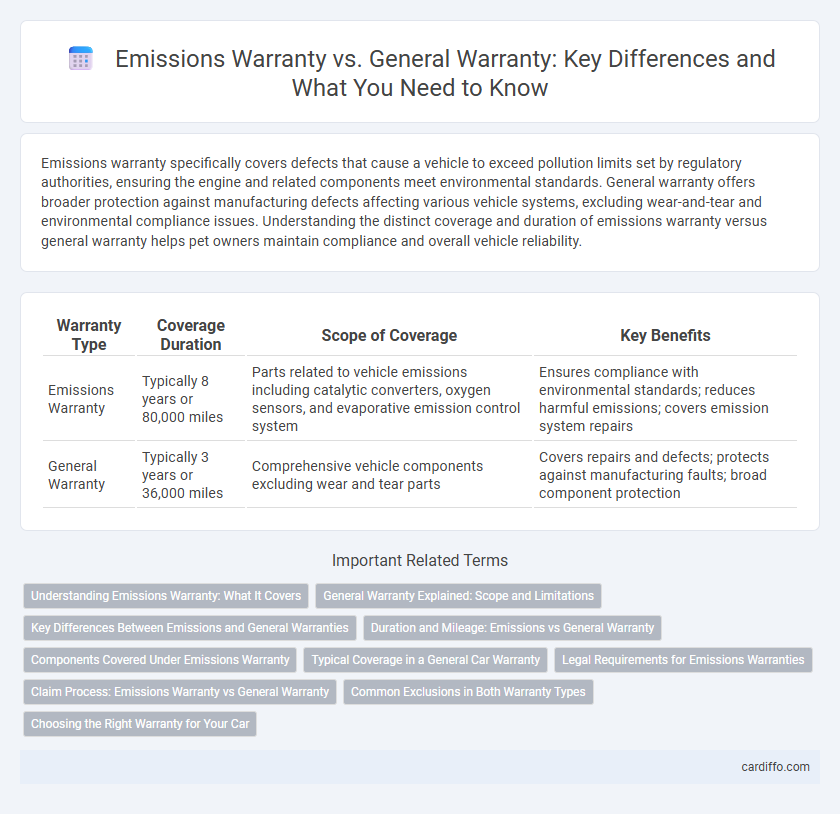Emissions warranty specifically covers defects that cause a vehicle to exceed pollution limits set by regulatory authorities, ensuring the engine and related components meet environmental standards. General warranty offers broader protection against manufacturing defects affecting various vehicle systems, excluding wear-and-tear and environmental compliance issues. Understanding the distinct coverage and duration of emissions warranty versus general warranty helps pet owners maintain compliance and overall vehicle reliability.
Table of Comparison
| Warranty Type | Coverage Duration | Scope of Coverage | Key Benefits |
|---|---|---|---|
| Emissions Warranty | Typically 8 years or 80,000 miles | Parts related to vehicle emissions including catalytic converters, oxygen sensors, and evaporative emission control system | Ensures compliance with environmental standards; reduces harmful emissions; covers emission system repairs |
| General Warranty | Typically 3 years or 36,000 miles | Comprehensive vehicle components excluding wear and tear parts | Covers repairs and defects; protects against manufacturing faults; broad component protection |
Understanding Emissions Warranty: What It Covers
Emissions warranty specifically covers components related to a vehicle's emission control system such as the catalytic converter, oxygen sensors, and evaporative emissions system to ensure compliance with environmental standards. This warranty typically lasts longer than the general warranty, often up to 8 years or 80,000 miles, reflecting stricter federal and state regulations on emissions. Understanding the scope of emissions warranty helps vehicle owners address potential pollution-related defects without incurring additional repair costs.
General Warranty Explained: Scope and Limitations
General warranty covers defects in materials and workmanship for a specified period, typically including major vehicle components such as the engine, transmission, and electrical systems. It excludes wear-and-tear items like brake pads and tires, and often requires regular maintenance to remain valid. Unlike emissions warranty, it does not specifically address pollution-control components but provides broader protection against manufacturing flaws.
Key Differences Between Emissions and General Warranties
Emissions warranties specifically cover the repair or replacement of components related to vehicle emission control systems, ensuring compliance with environmental standards, typically lasting 8 years or 80,000 miles. General warranties provide broader coverage for overall vehicle defects in materials or workmanship, often lasting 3 years or 36,000 miles. The primary distinction lies in emissions warranties' legally mandated protection for pollution-control parts, whereas general warranties focus on comprehensive vehicle reliability.
Duration and Mileage: Emissions vs General Warranty
Emissions warranties typically last between 2 to 8 years and cover mileage ranges from 24,000 to 80,000 miles, reflecting strict regulatory standards. General warranties often provide coverage for 3 to 5 years or up to 36,000 to 60,000 miles, focusing on broader vehicle defects and repairs. The extended duration and mileage limits of emissions warranties ensure compliance with environmental laws and protect critical components like catalytic converters and oxygen sensors.
Components Covered Under Emissions Warranty
Emissions warranty specifically covers components related to a vehicle's pollution control system, including the catalytic converter, oxygen sensors, and evaporative emission control system. These components are essential for maintaining compliance with environmental regulations and reducing harmful emissions. Coverage duration for emissions warranty generally exceeds that of the general warranty, reflecting the importance of these parts in meeting legal standards.
Typical Coverage in a General Car Warranty
Typical coverage in a general car warranty includes repair or replacement of major vehicle components such as the engine, transmission, and drivetrain due to defects in materials or workmanship. Emissions warranty specifically covers parts related to the vehicle's emission control system, ensuring compliance with environmental standards. General warranties usually have broader protection periods and encompass a wider range of mechanical issues compared to the more specialized emissions warranty.
Legal Requirements for Emissions Warranties
Emissions warranties are legally mandated by environmental regulations such as the Clean Air Act, requiring manufacturers to cover specific components responsible for controlling emissions for a minimum period, unlike general warranties which primarily cover defects in materials and workmanship. These legal requirements ensure emissions-related parts, including the catalytic converter, oxygen sensors, and evaporative emission control systems, receive extended coverage to comply with federal and state standards. Failure to provide adequate emissions warranties can result in regulatory penalties and compromise consumer protections under environmental laws.
Claim Process: Emissions Warranty vs General Warranty
The claim process for emissions warranties typically requires detailed documentation of vehicle maintenance and emissions system inspections to comply with environmental regulations, while general warranty claims focus on broader mechanical or component failures without such stringent environmental documentation. Emissions warranty claims often involve interaction with regulatory bodies and may require specialized diagnostics to verify emission control system performance. General warranty claims prioritize repair or replacement of defective parts under manufacturer guidelines, with fewer regulatory procedural steps compared to emissions warranties.
Common Exclusions in Both Warranty Types
Emissions warranties and general warranties commonly exclude damages resulting from accidents, misuse, or alterations not authorized by the manufacturer. Both warranty types typically do not cover wear-and-tear items such as brake pads, filters, and tires. Issues arising from lack of proper maintenance or use of non-approved fluids and parts are also frequently excluded from coverage.
Choosing the Right Warranty for Your Car
Emissions warranty specifically covers repairs related to a vehicle's pollution control systems, ensuring compliance with environmental regulations and reducing harmful emissions. General warranty encompasses a broader range of vehicle components, protecting against defects in materials and workmanship for a set period or mileage. Choosing the right warranty depends on your priority: emissions warranty is essential for long-term environmental compliance, while a general warranty offers more comprehensive protection for overall vehicle performance.
Emissions Warranty vs General Warranty Infographic

 cardiffo.com
cardiffo.com